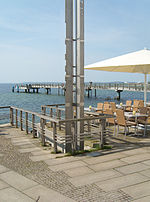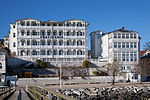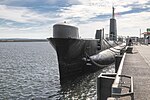Jasmund National Park

The Jasmund National Park (German: Nationalpark Jasmund) is a nature reserve on the Jasmund peninsula, in the northeast of Rügen island in Mecklenburg-Vorpommern, Germany. It is famous for containing the largest chalk cliffs in Germany, the highest of which is Königsstuhl (German = "king's chair"), rising to 118 m (387 ft) above the Baltic Sea. The highest point in the park as a whole is Pieckberg, at 161 m (528 ft) above sea level. The beech forests behind the cliffs are also part of the national park. Consisting of only 30 km2 (12 sq mi), this is the smallest national park in Germany. The park was founded in September 1990 by the last government of East Germany (GDR) prior to the German reunification. On 25 June 2011 the beech forest in the park was added to the UNESCO World Heritage List as an extension of the Primeval Beech Forests of Europe site because of its undisturbed nature and its testimony to the ecological history of Europe since the last Ice Age.
Excerpt from the Wikipedia article Jasmund National Park (License: CC BY-SA 3.0, Authors, Images).Jasmund National Park
L 303,
Geographical coordinates (GPS) Address Nearby Places Show on map
Geographical coordinates (GPS)
| Latitude | Longitude |
|---|---|
| N 54.55 ° | E 13.65 ° |
Address
L 303
18546
Mecklenburg-Vorpommern, Germany
Open on Google Maps










